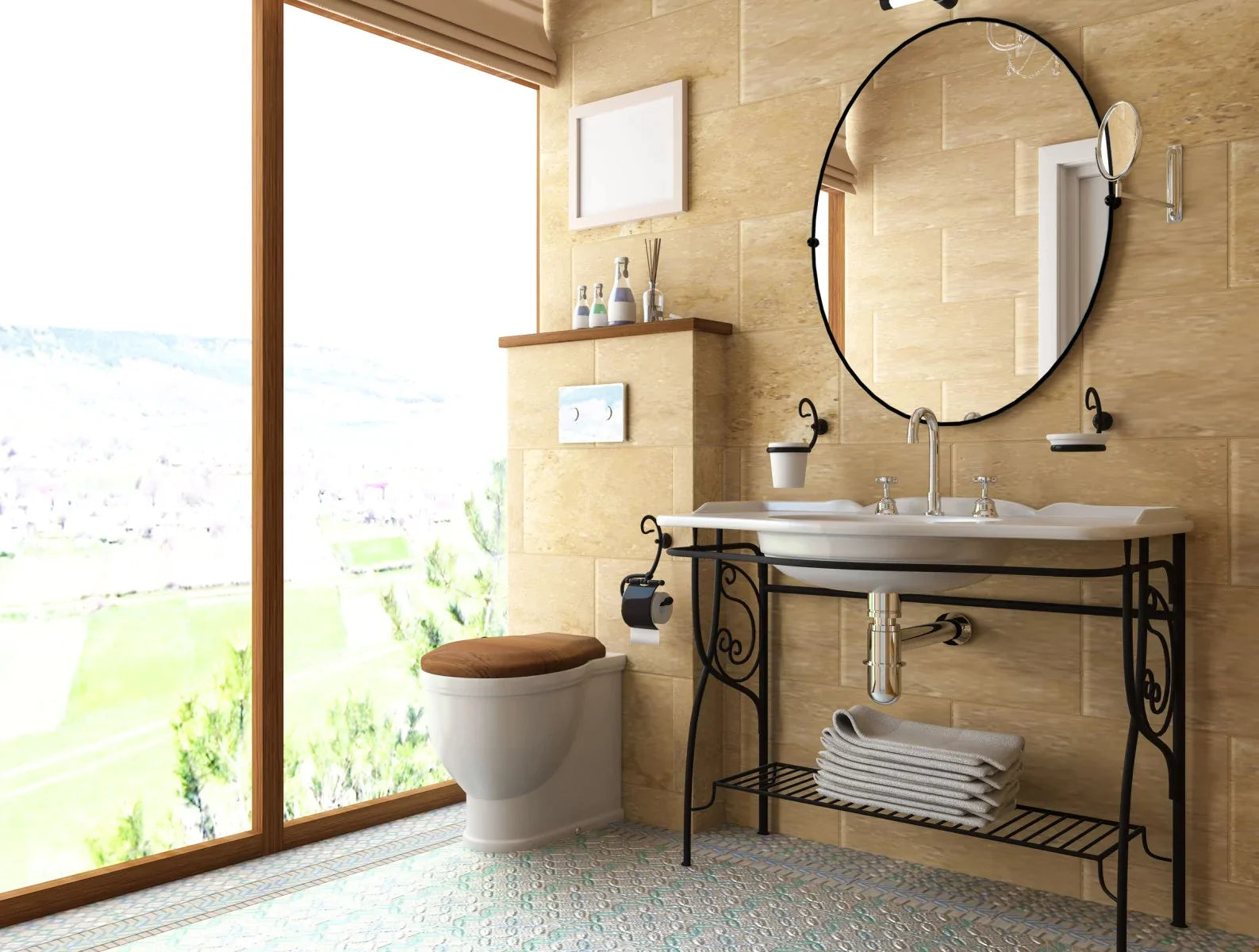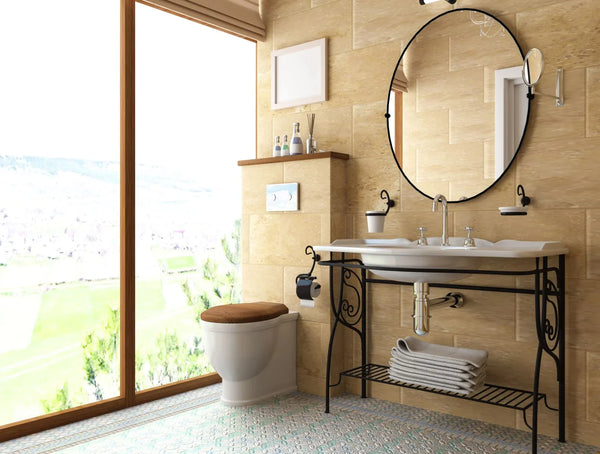Most homeowners dream of a spacious, airy bathroom filled with natural light. But the reality is that many bathrooms are dark — especially those in older homes. And how can you really brighten a room that only has one window, or doesn’t have any windows at all?
These design ideas will fill you with inspiration for bringing ample amounts of light into the bathroom.
Maximizing Natural Light
When your bathroom has at least one window, it’s important to maximize its natural light as much as possible. In addition to looking beautiful and inviting, natural light also offers a host of health benefits.
Exposure to natural light can reduce the risk of developing nearsightedness, especially in children and young adults. Natural light boosts levels of dopamine, which is essential for healthy, strong eye development, personal finance writer Beth Buczynski adds. Plus, having more natural light in a home also reduces energy consumption. Energy-efficient windows in particular reduce heat escape in winter months and preserve air conditioning in warmer months, sustainability resource The Greener Ideal explains.
One of the easiest ways to brighten a dark bathroom is clear the space around the window. If you have a window sill in your shower cluttered with soap bottles, for example, freshening up that space can let in more light from outside, David Michael McFarlane at Make Space writes.
Amping up your bathroom storage is another way to reduce clutter and boost the amount of light coming in from the window. Install recessed shelving and medicine cabinets instead of large armoires and vanity cabinets, real estate investor Christina El Moussa says. Adopting a minimalist mindset and keeping only the bare necessities in the bathroom can aid in this approach.
Swapping out blinds and curtains can also make a bathroom window brighter, interior designer Kelly Hoppen adds. She suggests using lightweight fabric, because this maximizes the amount of light let in while adding texture to the space. Fabrics and materials with metallic accents, weaves and strings can also help boost reflectivity in a small, but impactful way.
If you’re looking to add another window to your bathroom, consider a skylight or two. Skylights are usually placed in a ceiling and can’t be opened, but certain designs allow for fresh air to enter. Skylights are a particularly effective way to add light in dark, small rooms with just one or no other windows, architect and historian Kate Reggev writes.

Windowless Bathrooms
Windowless bathrooms might at first seem drab, but creative, colorful design approaches can truly transform the space.
Consider the bright and friendly bathroom update featured by Chris and Julia Marcum at their DIY blog Chris Loves Julia. Here, a peachy-salmon color called calamine is used to create a warm, soft and inviting feel in the windowless bathroom. This color was also chosen because it contrasts nicely against the subway tile.
Elizabeth Stamp at Architectural Digest agrees that windowless bathrooms can be either colorful and creative or clean and neutral. While it’s true that whites and grays reflect brightness, it’s not a bad idea to embrace the darkness of a small bathroom. Using a rich, moody hue such as cobalt blue can add drama, especially when paired with a crisp white.
Some bathrooms are too small and dark to rely on the interplay of color and natural lighting alone. In this case, choosing the right light fixtures can make up for lack of light. Wall sconces and cove lights are optimal fixtures to boost light without taking up space, Aubrey Almanza at Reader’s Digest writes. Mounted wall lights also work better in small bathrooms especially those with low ceilings, as these create an unflattering look when overhead lighting is used.
Mirrors
Adding reflective surfaces to a dark bathroom will brighten it up. In particular, placing a mirror adjacent to the window or opposite the window reflects more light, architect Regina Yunghans says. And putting a mirror next to a window will mimic that window, making it appear that there are more windows than there actually are. When placed opposite a window, the mirror will bounce the light around the room and reflect its views.
The size and angle of a mirror determines what gets reflected, adds Country Living digital editor Emma-Louise Pritchard. The right angle can reflect outdoor light, sky and greenery, making a small bathroom seem larger. The bigger the mirror, the bigger the sense of space created.
Additional reflective surfaces also bring energetic light and brightness to a small bathroom. Shimmery gold, silver and other metallics can add light to a small, dark bathroom, Kelsey Kloss and Monique Valeris at Elle Decor write. Whether a mirror with metallic edges, a gold light fixture or piece of artwork with light-reflecting paint, such accessories can make any bathroom design scheme feel brighter and more luxurious.

Wall and Ceiling Paint
Paint can play a significant role in the amount of light in your bathroom. This is because it can either absorb or reflect light, Gerry Roth, home improvement contractor writes. Painting the ceiling a shade or two lighter than the walls is an easy way to reflect more light, he adds. However, painting the ceiling stark white can be distracting when there is no other white in the room.
If you’re hoping to reflect light using the ceiling but don’t want an all-white bathroom, consider a complementary color for the ceiling, color expert Dee Schlotter says. A subtle transition between the wall and ceiling colors can boost the sense of height in the room, making it feel both brighter and larger.
As for wall colors, cool tones can add more light to your space, the team at Stone Martin Builders writes. This doesn’t necessarily mean you’ll have to rely on an overtly cool color such as green or blue, however. It means that the colors you use should have cool undertones, rather than warm undertones, to make the space feel more open.
Paint finishes have a large influence on the atmosphere of the room as well, color designer Sue Kim points out.
While matte finishes add serenity and calm, high-gloss finishes provide energy and excitement. In rooms with little natural light, however, Kim recommends a satin finish that reflects light and boost color. Interiors journalist Jill Macnair agrees that a paint’s finish can make or break reflectiveness and sense of light in a room.
She prefers opting for high-gloss paints in small rooms with strong colors. This helps bounce light around whether the shade is light or dark. She also suggests using colorful, high-gloss paint as an accent color on a feature wall or built-in shelf.
If you’re unsure about which color to choose for your bathroom, consider how sunlight enters your room. North-facing rooms should be painted in cool, bluish tones, while south-facing rooms will benefit from skylights paired with warm and cool colors, real estate writer Lisa Kaplan Gordon explains. East-facing rooms look best when painted in reds, oranges and yellows.
Images: podsolnukh/©123RF Stock Photo, bialasiewicz/©123RF Stock Photo, Adrien Villez







